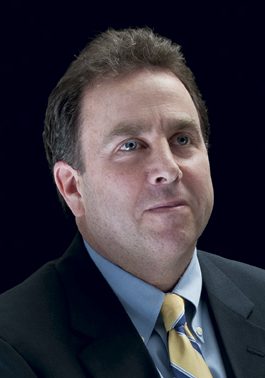Focus on architects and engineers insurance
As the number of new build starts remains steady, so does the market competition
By Lori Widmer
All that goes up must come down. Likewise, a down cycle eventually turns upward again.
According to data released by Dodge Data & Analytics, new starts in the construction industry this year are predicted to total $808 billion, nearly equal to that of 2018 starts, which totaled an estimated $807 billion.

-Robert Cunningham
Senior Vice President of Professional Liability
Aspen Insurance
For the insurance market, it means more competition. The Ames & Gough PLI Market 2018 report shows favorable insurance market conditions for architect and engineering firms. Despite that, A&E professional liability insurers saw their premium volume grow in 2017 and continue into 2018.
However, the new business that was driving that growth has waned and premium rates are declining slightly. It’s a market that Robert Cunningham describes as robust.
Cunningham, senior vice president of professional liability for Aspen Insurance, says the current state of the market means that there are plenty of carriers and product offerings available to respond to the changing needs within the A&E space. That makes it easier for design firms to manage their risks, he says.
That’s particularly important given the increased demands firms are facing, Cunningham says. “Design firms continue to face requests for increased limits of liability or project- dedicated limits. However, not every carrier offers all types of products, and many have targeted strategies to underwrite only a certain profile of design firm. Therefore, it is important for agents and brokers to understand each carrier’s underwriting appetite to determine the best options for their clients.”
That includes a more comprehensive insurance plan for A&E firms. Audrey Lau, vice president and product head of the A&E line for Hiscox, says that in such an established, mature market, there are plenty of options for professional liability coverage. According to Lau, markets now include technology, media, and crisis response as standard coverage enhancements on most forms.
Thank the competitive market for such standard enhancements, she says. “There are currently around 50 carriers/markets writing this line of business, so pricing continues to be competitive; however, losses for this class are trending up and several carriers have pulled out of the market in the last couple of years. This might start to impact capacity and rates on larger A&E classes.”
It’s certainly impacted how the markets behave, says Ethan Buckles, producer and broker for USG Insurance Services’ commercial lines division. “The most unique thing I have seen in this space is that binding markets that are traditionally casualty-driven are now allowing us to add PL (professional liability) to certain classes that previously could only be covered by a separate A&E policy. A great example would be ‘drafters.’ As long as they don’t have ‘stamping’ authority for designs, the carrier deems it as a lesser E&O exposure. Therefore, they are willing to take it on for an additional premium that generally is going to be lower than what you could find for stand-alone A&E.”

-Audrey Lau
Vice President and A&E Product Head
Hiscox
That’s making it a sweet market for buyers and a highly competitive one for insurers, Buckles adds. “When you have an insured with low revenues and you are looking at minimum premiums, the difference between a $500 additional premium for throwing in PL coverage and a $2,500 minimum premium for a full-blown A&E policy likely is enough to win the deal.”
In fact, the name of the game is differentiation, says Buckles. “In general, one thing I have noticed is that markets have recently revised their A&E policy forms to include more expansive coverage, close gaps, and offer additional sub-limits as a way to separate themselves from competitors. There are enough carriers offering this product that you cannot always win simply on price alone, but an enhanced form will help close the sale.”
The claims remain
The presence of such fierce competition is indicative of the current claims picture, which Cunningham says is relatively stable. For the last decade, Cunningham says there haven’t been significant trends driving A&E claims. However, he points out a few claim areas that are driving higher litigation expenses and settlements. Among them are the costs involved in electronic discovery and data storage, in addition to attracting and retaining talent.
Electronic discovery and data storage requirements, says Cunningham, “affect design firms as they store a tremendous volume of electronic documents and files. These line items in defense counsel budgets can be a very large percentage of the overall defense estimate.”
Another hit to the bottom line is the ongoing talent shortage across many industries. Particularly hard hit has been the construction industry, which Cunningham says is hampering design firm business. “With the construction industry rebounding over the past several years, almost all design firms have grown and have impressive backlogs.”
Yet it’s not merely finding talent but holding on to it that’s frustrating firms in their ability to manage the progress of a project, says Cunningham. “There also is a trend where younger professionals are quick to move to another firm for higher compensation or a perceived better opportunity. Almost every firm I speak with across the country has made similar comments. As firms hire replacement personnel, there is a learning curve for the new employee, placing increased demands on other employees and creating the potential for increased errors and omissions.”
Then there are the traditional types of claim drivers. Lau sees claims activity landing on the architects “mainly because they are often the point of responsibility for the entire design team.”
Lau says that certain project types hold less appeal for insurers from a claims perspective. “Condos and HOA claims continue to be problematic for the entire industry. Many markets have limited appetite for firms that have the HOA exposure.”

-Ethan Buckles
Producer and Broker, Commercial Lines Division
USG Insurance Services
Desperately seeking advice
Such nuances in the market mean that clients need more guidance than ever to successfully cover their risks, including those they may not be aware of. Contract risk management, says Lau, is a much-needed service that agents and brokers can bring to their clients. “Unexpected claims and large settlements often arise when insureds take on disproportionate contractual obligations and liabilities.”
Yet, Lau says, too many small- to mid-sized firms lack in-house risk management or legal counsel. That means they’ll turn to their agents and brokers, she says. “Some brokers may have the in-house capability to assist clients with this, but most will partner with carriers that offer risk management services to their insureds.”
And it’s the servicing of the client that will help agents and brokers differentiate, says Cunningham. “Based on my experience, the most successful agents and brokers are those who immerse themselves in the A&E community.”
He advocates for agents and brokers to build an expertise in the field, including understanding the challenges A&E clients face. “Often they are confronted with complex contractual requirements or managing issues that arise in various stages of a project. The A&E community values an insurance professional’s opinion and suggestions, not only how it relates to their professional liability coverage but how to mitigate risk and reduce client conflict.”
That includes working with defense counsel and the insurer, learning all one can about loss control in the industry, and educating oneself on contract management, he adds.
“Working with defense counsel and insurance carriers, and researching loss control advice and contract management tips, can empower agents and brokers to become an invaluable resource for their A&E clients,” Cunningham says.
For more information:
Aspen Insurance
www.aspen.co
Hiscox
www.hiscox.com
USG Insurance Services
www.usgins.com
The author
Lori Widmer is a Philadelphia-based writer and editor who specializes in insurance and risk management.






